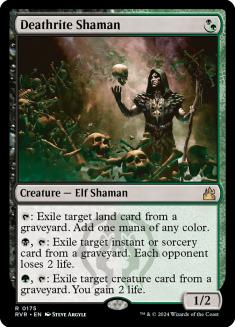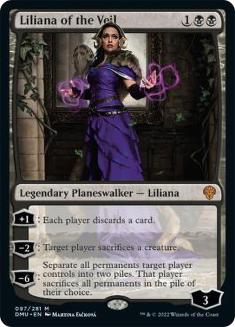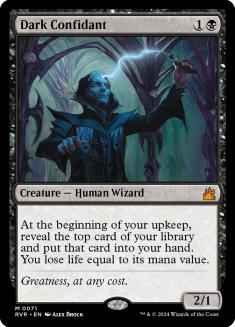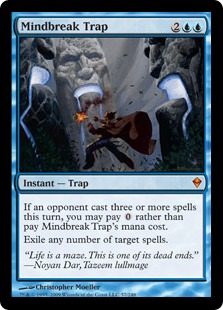Last weekend was a pretty good one for me, to say the least. I played two decks I believed were the best in their respective formats and happened to strike a balance of deck choice, luck, and the right mindset to end up with a 2nd place and 4th place finish at SCG Open: Atlanta. I have yet to win an SCG Open, and I badly want the trophy that still eludes me, but I can’t feel anything but satisfaction over the results of this weekend.
In Legacy, I played a Jund deck featuring the Punishing Fire / Grove of the Burnwillows combo. Ever since playing against a Jund deck way back in the Legacy Open in L.A. in December, I have wanted to play this deck. I decided in December that I was going to play Jund at the next Open I attended, and if anything, the success Jund has put up in the month and a half to follow was confirmation that I was making the right choice. I was set on Legacy.
Standard was a different animal. For weeks I had been thinking about what effect Gatecrash was going to have on Standard and what the best strategy was going to be to attack this fresh format. SCG Open: Atlanta was the first event featuring Gatecrash, and I wanted to do everything I could to take the tournament by storm with one of the stupidly powerful cards in the set. Was Obzedat gonna brain ’em with drain? Was Aurelia gonna get furious up in here? Was it the day of Reckoning?
All I knew is that I wanted to be playing the most powerful deck featuring the most powerful strategy and hope that my opponents were unprepared to deal with it. Mostly, this meant I was brewing a variety of Naya lists and fine-tuning them into the most efficient and brutal killing machines I could. Thundermaw Hellkite into Aurelia, the Warleader for the casual 21? Razzle dazzle! Loxodon Smiter with Ghor-Clan Rampager and Boros Charm? Boom shakalaka!
A full week before Atlanta, those plans came to a crashing halt. Brad Nelson called me to tell me a phrase I’ve come to expect hearing from him. “I broke it.” For those who don’t know how Brad Nelson operates, this can only mean one of two things. He actually broke the format, or, more commonly, he didn’t break the format. If you haven’t guessed by now, he says “I broke it” about every single deck he has ever built, whether or not it’s actually true. Rumor has it his 1-2 draft deck from FNM three months ago “broke the RTR draft format,” but that is still up for debate.
This time, however, he was right. It only took seeing his deck in action a few times before I threw away all of my other ideas and knew this was exactly what I was going to play. After all, it was powerful; my opponents were going to be unprepared to deal with it; and it featured the strongest Gatecrash card of them all…
You know what card I’m talking about. I’m talking about the one and only Cartel Aristocrat. Yeah, that’s the one. The barely Limited playable Grizzly Bear with a restrictive mana cost and a marginal ability was exactly the kind of Constructed powerhouse I was looking for.
Brad’s deck was an update on the Human Reanimator* deck that had experienced some minor success in the prior Standard season. Cartel Aristocrat provided the deck an avenue to go infinite by looping Fiend Hunter and Huntmaster of the Fells with Angel of Glory’s Rise**. Executing this combo gives you infinite life and infinite 2/2 Wolves. While the combo involves a full four cards to execute, it is still essentially a one-card combo, since casting an Angel of Glory’s Rise or reanimating her with Unburial Rites was all you needed to start the chain.
** Here is a full explanation of how the combo works: Cast or reanimate an Angel of Glory’s Rise to bring back all of your Humans. Use Fiend Hunter to target the Angel of Glory’s Rise and then gain life and generate Wolves with your Huntmaster of the Fells. Using Cartel Aristocrat, sacrifice all of your Humans, saving the Fiend Hunter with the Angel underneath it for last. When you sacrifice that Fiend Hunter, Angel comes back into play and returns your Humans. You gain another 2 life and create another Wolf with Huntmaster, and you exile the Angel of Glory’s Rise again with the Fiend Hunter, allowing you to start the chain again. You can repeat this loop ad nauseam until you are at an arbitrarily high life total, and it’s safe to say that your opponent is facing down lethal.
Even if you are missing a combo piece or two, Angel of Glory’s Rise is still capable of gaining a lot of value simply by bringing back some Huntmasters and Fiend Hunters to obtain board control. You can win by just grinding out value with Unburial Rites and Angel of Glory’s Rise, and anytime you are fortunate enough to establish the combo it is nearly impossible to lose.
For reference, here is the deck:
Creatures (17)
- 4 Fiend Hunter
- 4 Huntmaster of the Fells
- 4 Angel of Glory's Rise
- 1 Cathedral Sanctifier
- 4 Cartel Aristocrat
Lands (23)
Spells (20)

I won’t go into a lot of detail about the construction of the deck or our choices in that regard, as Brad went over that in his article this week. Instead, I’d like to briefly discuss why we chose the sideboard cards we did and then talk about the tournament itself.
Our strategy was inherently more powerful than anything our opponents could possibly do in this format. Gaining infinite life put the game out of reach for any deck looking to win by damage. Generating infinite creatures made stabilizing the board a nightmare for any control deck, especially since Supreme Verdict did nothing to stop the combo as long as you hid your Angel underneath of a Fiend Hunter.
Based on that premise, we tooled our sideboard to hate on the hate people were going to bring in against us. Haters gonna get hated on. If they can’t beat our deck without sideboard answers, then we decided our best plan of action in post-board games was to combat their sideboard with ours and stick to the same combo.
This led to us playing the following answers for specific problems:
- Ray of Revelation for Rest in Peace
- Purify the Grave and Slaughter Games for Angel of Glory’s Rise (the mirror match)
- Cathedral Sanctifier for aggressive strategies
- Appetite for Brains for Slaughter Games
The only card we were unprepared to beat was Grafdigger’s Cage, as we didn’t have a single answer for it in our 75. We rightfully assumed nobody would be playing that card. Moving forward, that won’t be the case, and Abrupt Decay is probably needed to deal with it in post-board games.
The Tournament
While I didn’t put much time into testing for this tournament, having only played a few games with the Human Reanimator deck and none with Punishing Jund, I still felt more prepared for this event than I have for a tournament in a long time.
The reason had nothing to do with Magic. In fact, I have not been playing much Magic at all lately. It’s been a few weeks since the last time I logged into Magic Online; outside of Versus videos, I don’t often play during the week.
Why then did I feel prepared? The reason actually goes all the way back to last October.
On a whim one night, I decided that I wasn’t happy with where I was at, and I wanted to work on improving myself. I haven’t looked back since. At the beginning of November, I began a regimen of dieting, healthy eating, exercise, and drinking lots of water. Since then, I’ve lost 47 pounds; I have significantly more energy than I used to have; and I simply am a much happier person.
It definitely affected my play in a positive way. Having more energy is great by itself, but I was also less emotionally affected by things “not going my way,” and I was able to focus solely on the tournament without any external worries clouding my thought processes. I had to play Magic for 14 straight hours on Sunday, and I still felt alert and functioning in my later matches.
I’m not writing this article to extol the merits of a healthy lifestyle to improve your tournament play, but I don’t think it was a coincidence that I had a strong weekend after getting myself into a good mental and physical state of being.
Regardless of how I felt, I still had to battle 13 rounds if I wanted to win this tournament, and my opponents had no intention of making it easy on me.
Standard
Rather than bore you with the play-by-play details of how I cast some Farseeks on turn 2, flashed back some Faithless Lootings and went Grisly on my opponent’s end step, I am instead going to stick to the meat and talk about some of the closer and more interesting matches I played.
I started off the tournament 4-0, rattling off a number of easy wins, thanks to opponents getting game losses for tardiness, mulligans to four, and the deck simply steamrolling them.
Round 5 is when things got tough. I was paired against Bant Hexproof. I had not prepared for this matchup at all, and I had no idea if this was a good matchup for me or not. My hunch was that it wasn’t. Thankfully, my opponent kept a one-lander game 1 that didn’t pan out, and a quick Fiend Hunter on his lone Avacyn’s Pilgrim along with a Huntmaster that flipped was enough to seal the deal.
I sided out Huntmasters, which seemed too slow, along with Farseeks, since they are much weaker without Huntmaster in your deck. I brought in Cathedral Sanctifiers and my Ray of Revelations. I knew that the Hexproof deck was incapable of beating infinite life, so comboing with a Sanctifier was just as good as a Huntmaster, since the infinite creatures weren’t relevant. Sanctifier had a much bigger impact on the game, as it was better for buying time to establish the combo.
In game 2, he played a turn 2 Silverblade Paladin, and I was basically dead before I could do anything.
Game 3, he had a turn 2 Geist of Saint Traft into double Rancor on turn 3 into Hands of Binding on it turn 4. I was happy that I had boarded out my Huntmasters for Sanctifiers here, as I was able to quickly drop double Sanctifier and trade them for his Geist of Saint Traft. After a Fiend Hunter took care of his follow-up creature, we were left with a board where I was basically dead to almost any creature along with the two Rancors in his hand, and my clock was very slow, giving him plenty of time to draw one.
In the meantime, I was furiously digging through my deck with Grisly Salvages and Faithless lootings, but I couldn’t find an Angel…
Finally, he drew a Geist of Saint Traft. If he had anything to go with those 2 Rancors in hand, I was dead. My next draw step needed to Rise to the occasion.
I peeked at my top card AND…it was pretty Glorious, to say the least. It was, without a doubt, the best 4/6 flier for seven I’ve ever drawn.
5-0
The next round I beat Jund Midrange. Jund can’t interact with you game 1, and game 2 I got lucky that he flooded out.
6-0
Round 7 I was paired against Joseph Herrera, who I would later face in the finals of the tournament. This round wasn’t particularly interesting, as he steamrolled me on the play game 1 thanks to his turn 2 Thalia, and in game 2 he ripped a Rest in Peace the turn before I was going to combo him out, and I died shortly thereafter.
6-1
Round 8 was against U/W/R Control. I easily won game 1 thanks to his mulligan to five and his deck’s inability to interact with the combo. Game 2, which was featured on camera, was possibly the most interesting game I played in the tournament. There was quite a bit of interaction between my Cartel Aristocrat, Fiend Hunters, and his two copies of Izzet Staticaster. He had no pressure on me, but all of my Unburial Rites were in the bottom 10 cards of my deck, and it took me a long time to draw a Cavern of Souls for the Angel in my hand, so this game dragged on quite a while. Regardless, outside of a Rest in Peace, he had no way to take over the game, and I had all the time I needed to win.
7-1
When I checked the pairings board for round 9, I saw my opponent was Chi Hoi Yim. Even though I knew he was on U/W/R, a good matchup for the deck, I still wasn’t too pleased, as he had to be the best player I could have been paired against this round. Regardless, I manage to beat Chi Hoi every time we play, and this was no different. He had only one Rest in Peace in his 75, and Mizzium Mortars wasn’t going to get the job done.
8-1
I drew the final round to lock up Top 8.
Quarterfinals
My opponent was on a 4-Color Token deck that looked like it had really good game against a lot of the field, but it had a pretty slow clock and no disruption and thus was a huge underdog against me. In addition to the bad matchup, he had to mulligan at least three times in two games, and I found myself quickly on my way to the semifinals.
Semifinals and Finals
http://www.starcitygames.com/events/coverage/1561_semifinals_andrew_schneider_vs.html
http://www.starcitygames.com/events/coverage/finals_joseph_herrera_vs_brian.html
Glenn Jones did an excellent job covering both of these matches.
I got lucky in game 3 against Andrew Schneider, having the perfect nut draw against him to break serve and steal a game from him when he was on the play.
I got unlucky in game 3 against Joseph Herrera, having my Grisly Salvage and following draw steps fail to yield a land to cast the Huntmasters and Angel of Glory’s Rise in my hand. I was stuck with the perfect cards and yet no ability to cast any of it. It felt like the flavor text on one of the cards in the Judgment wish cycle. “He wished for the combo, but not the mana to cast it.”
You win some. You lose some.
Legacy
I didn’t have much time to dwell on my finals match because about 30 minutes after that match ended, I was sitting down for the Legacy player meeting.
Even though I had just come off a solid Standard performance, I wasn’t satisfied, and I had the hunger to do one better in Legacy. Being that close and missing out on victory just made me want it that much more.
Also, Brad Nelson really wanted to just skip Legacy and go home, and he was hoping I would drop out early from the tournament. No way was I missing out on this. I had wanted to play Legacy Jund very badly for over a month and a half, and I came to the tournament more to play Legacy than Standard. Besides, it would be a shame to just let Brad get his way.
I was in it to win it. Bring it on.
I used Pat Cox Jund list from GP Denver as the foundation for my list.
Creatures (17)
Planeswalkers (4)
Lands (22)
Spells (17)

I wanted to keep the majority of his list intact, but I knew I wanted to be playing Punishing Fire / Grove of the Burnwillows as well because that combo provides you with inevitability against every single fair deck in the format. When you combine Jund’s natural two-for-ones with a powerful engine that kills creatures and planeswalkers and serves as reach, you get a deck that simply dominates any non-combo deck.
Most combo decks are certainly tougher matchups. They don’t really care about Punishing Fire, as they lack useful creatures to target with it, and it’s way too slow to race them. Jund lacks access to Force of Will, so you are forced to rely solely on discard spells to interact with their combo. This leaves you super vulnerable to cards like Leyline of Sanctity, which also shuts out two of Liliana’s abilities.
Still, Jund doesn’t just fold to combo decks. Typically your first discard spell (hopefully a Thoughtseize or Duress on turn 1) is enough to slow them down enough to buy you time to cast another. If you can chain discard spells long enough to cast Liliana of the Veil, you will typically win. Liliana’s +1 every turn decimates any combo deck relying on their hand to win the game, such as Storm or Belcher. Liliana’s edict effect can also be relevant against certain types of combo, forcing your opponent to sacrifice their Progenitus or Emrakul.
At any rate, I wanted my sideboard to be loaded with combo hate cards. I cut some of the weaker cards from Pat’s sideboard, such as the Ancient Grudges, and replaced them with more powerful anti-combo cards, such as Mindbreak Trap. Mindbreak Trap gives you a chance against decks that can turn 1 you, like Storm and Belcher, while the discard spells give you a chance against any of the slower combo decks that typically don’t try to kill you until turn 3 or 4.
I ended up with this list:
Creatures (15)
Planeswalkers (4)
Lands (24)
Spells (17)
Sideboard

The only two changes I would immediately advocate is to find room for the fourth Bloodbraid Elf maindeck, as the card was amazing for me all tournament long, and I sided it in almost every match. I would also like access to a fourth Abrupt Decay to win Tarmogoyf fights, and I wouldn’t mind a few Obstinate Baloths somewhere in the SB to combat burn decks and be a solid threat in the mirror match. Baloth dodges Lightning Bolt, Punishing Fire (once), and Abrupt Decay, and he can be a surprise “Gotcha!” against Liliana’s +1 ability.
As for the tournament itself, I mostly just steamrolled over all of my opponents. My one loss in the Swiss came to Tony Chu in the who got luckier skill-intensive Jund mirror. Tony beat me again in the semifinals, meaning that I lost four matches on the weekend to two players who had a combined average finish of 1st place.
I guess if you’re going to lose, might as well lose to the guy who wins it all, right?
I also beat Owen Laufersweiler, who finished in 3rd place, in round 6. I mention this to note that a lot of the Jund players were forced to prey on each other in the Swiss rounds, and yet we still made it into the Top 8. For the three Jund players in the top 4, none of us lost a single match to a non-Jund opponent prior to that top 4.
The deck is pretty damn good.
Before I close out, I want to leave you with my favorite memory from the weekend and a bit of a fun, thought-provoking exercise.
In round 8 of the Legacy Open I was playing against Belcher in a win-and-in for Top 8. Game 1, I didn’t know what I was playing against, kept a hand without disruption, and found myself quickly Belched upon.
Game 2, I mulliganed a weak seven-card and saw the following hand at six cards. I was on the play:
The hand had everything I could possibly want against Belcher. What more could I ask for?
Oh right. Lands. I guess I could have asked for a land.
I tanked on this hand for a long time. Eventually I decided that I had a reputation for loose keeps I needed to protect. Keep! My opponent was pretty flabbergasted when I simply passed on turn 1. Regardless, he went for it on his turn 1; I broke his mind, and a few turns later I drew a fetchland and won the game from there.
Would you keep it, or do you think I had better odds to win on a mull to five? Let me know in the comments. I can see good arguments either way.
Game 3, I savagely ripped an Engineered Plague to cast on turn 2 when I was facing down a fully emptied warren.
Sometimes you just run hot.
Thanks for reading,






